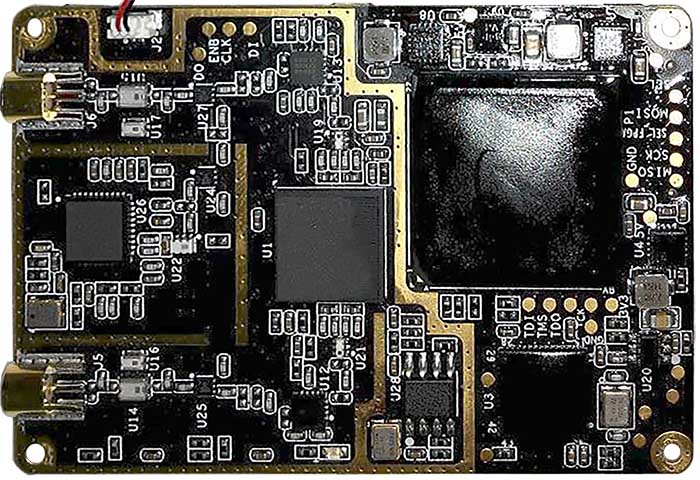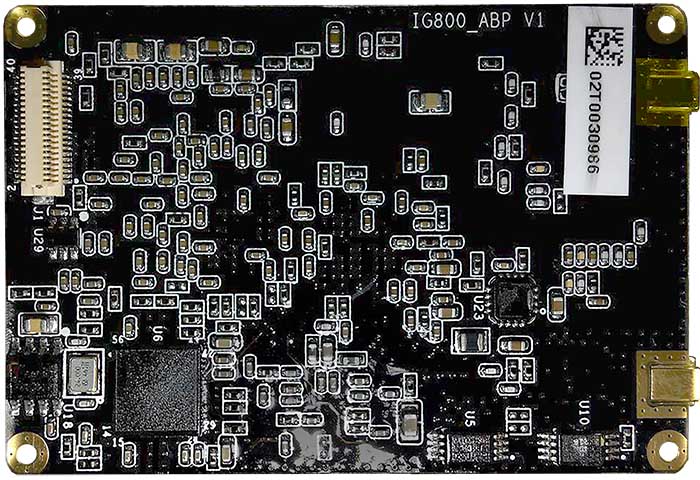IG800 Air OFDM Transceiver board
Function
Variants
Parts
Programming
External interfaces
Service interfaces
Board view
Schematics
The Air Side OFDM Transceiver board is responsible for pairing with Ground Side and communicating with it. The name comes from Orthogonal Frequency Division Multiplexing - which is a way of transferring broadband data. It implements the Lightbridge technology, and is transferring both data packets and video stream.
Known versions of the board are listed below. Additinally, the board is very similar to IG810 Air OFDM Transceiver board.
| Marking | Overview |
|---|---|
| IG800_ABP.V1 |
| Marking | Amt. | Pkg. | Function | Specification |
|---|---|---|---|---|
| AD9363 | 1 | 144-ball 10x10 CSP-BGA | Analog Devices Agile Radio frequency (RF) 2x2 transceiver with integrated 12-bit DACs and ADCs; Lightbridge RF transceiver | description |
| Altera Cyclone | 1 | UFBGA | FPGA; Lightbridge digital data scrambler; handles input and output data streams of the RF transceiver | description |
| Chips | Firmware | Description |
|---|---|---|
| Altera Cyclone + Flash | m1900 | Lightbridge FPGA air part; NAND flash memory stores the programming and the FPGA chip reads it during each startup. |
| Marking | Overview |
|---|---|
| TODO |
The following service pads exist on this board:
| Marking | Overview |
|---|---|
| TODO |
Top of a IG800_ABP.V1 board:
Bottom of the IG800_ABP.V1 board:
flowchart LR
Interboard-Encoder((inter-<br/>board conn<br/>to Encoder))
Interboard-Encoder== video<br/>over<br/>USB ===USB-Deserializer
Interboard-Encoder-- DUML ---Lightbridge-MCU
subgraph Air OFDM Transceiver board
USB-Deserializer[Cypress<br/>FX2LP USB<br/>deserializer]
Data-Scrambler[Altera FPGA<br/>data encoder/<br/>scrambler]
Lightbridge-MCU[Lightbridge<br/>MCU]
Serial-Flash[Serial<br/>flash]
WiMAX-Transceiver[WiMAX<br/>double<br/>transceiver]
Lightbridge-MCU-- tx config<br/>and DUML ---Data-Scrambler
Lightbridge-MCU-- radio config<br/>via SPI ---WiMAX-Transceiver
Serial-Flash-- bitstream ---Data-Scrambler
USB-Deserializer===Data-Scrambler
Data-Scrambler===WiMAX-Transceiver
WiMAX-Transceiver===RF-Tx-Amp-A[RF power<br/>out amp]
WiMAX-Transceiver---RF-Rx-Amp-A[RF LNA<br/>inp amp]
WiMAX-Transceiver===RF-Tx-Amp-B[RF power<br/>out amp]
WiMAX-Transceiver---RF-Rx-Amp-B[RF LNA<br/>inp amp]
RF-Switch-A[RF<br/>switch]
RF-Switch-B[RF<br/>switch]
RF-Tx-Amp-A===RF-Switch-A
RF-Rx-Amp-A---RF-Switch-A
RF-Tx-Amp-B===RF-Switch-B
RF-Rx-Amp-B---RF-Switch-B
end
Antenna-A1((Ant))
Antenna-B1((Ant))
RF-Switch-A---Antenna-A1
RF-Switch-B---Antenna-B1
Thick lines present propagation of video data. The live video feed and data packets (incl. telemetry) come from Video Encoder board through inter-board connector. Video is wrapped with USB packets, so first the USB deserializer handles it and prepares input data for the FPGA. The FPGA, during power-on initialization, loaded a bitstream from Serial Flash, and became a digital data encoder for the Lightbridge protocol. It prepares the video data and telemetry to be sent through radio channel, and supplies it to WiMAX Transceiver, from where the modulated signal is amplified and sent toward antennas.
The antennas can also receive DUML packets from the RC, in which case the input RF signal is amplified through LNA, received through WiMAX Transceiver, and provided to the FPGA for error correction and unscrambling. The DUML packets are provided to the Lightbridge Main Controller Unit, and from there routed to Video Encoder board over CAN.
The MCU micro-controller is responsible for configuring the transmission by sending SPI commands to the WiMAX Transceiver, and setting logic signals on some configuration lines of the FPGA.
No schematics available.
This page is created by drone enthusiasts for drone enthusiasts.
If you see a mistake, or you know more about specific subject, or you see an area for improvement for the wiki - create an issue in this project and attach your patch (or describe the change you propose).

